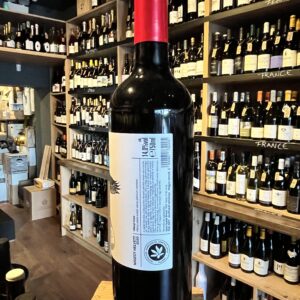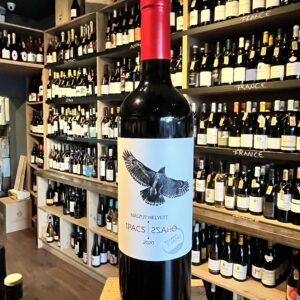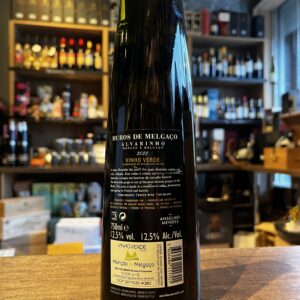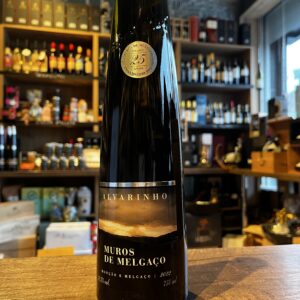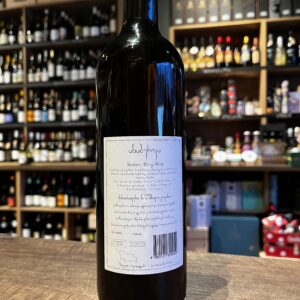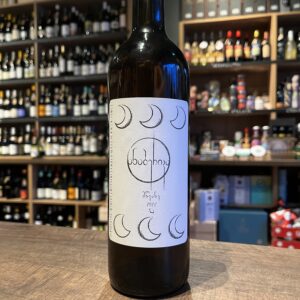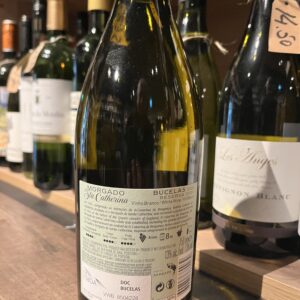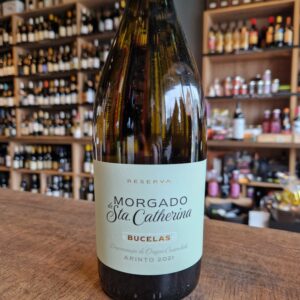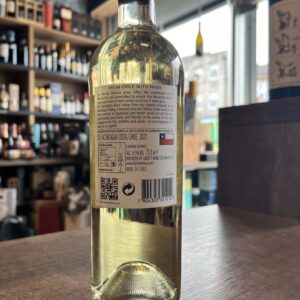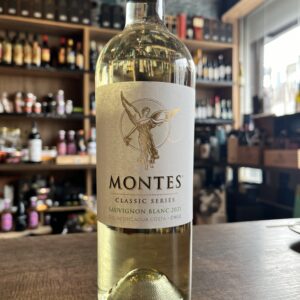-
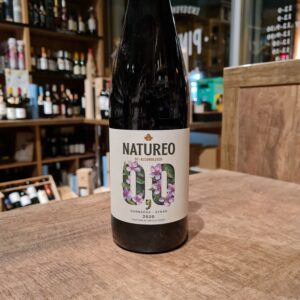 Red wine without alcohol (dealcoholized) made with Grenache and Syrah grapes.5% of the coupage maintains a brief aging in new French oak and subsequently undergoes the dealcoholisation process, maintaining all its aroma and flavour. This non-alcoholic red wine has an intense and delicious flavour. If you are a lover of red wines and want to avoid alcohol, this is a good option. If you do find the fruit coming up too strong, try chilling it to lower that strength. Serve it with pasta, roasts and game dishes
Red wine without alcohol (dealcoholized) made with Grenache and Syrah grapes.5% of the coupage maintains a brief aging in new French oak and subsequently undergoes the dealcoholisation process, maintaining all its aroma and flavour. This non-alcoholic red wine has an intense and delicious flavour. If you are a lover of red wines and want to avoid alcohol, this is a good option. If you do find the fruit coming up too strong, try chilling it to lower that strength. Serve it with pasta, roasts and game dishes -
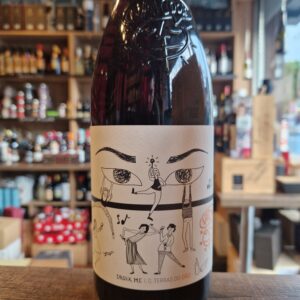 Nat Cool is an innovative, naturally “cool and funky” concept initiated by Niepoort in the Vinho Verde wine region. The movement later expanded into Bairrada and the Douro Valley and is now represented in various Portuguese as well as international wine regions. Nat Cool is not just about producing low-intervention wines – it embodies a movement uniting many different producers striving towards a shared goal of crafting uncomplicated, light and easy-to-drink wines. In 2020, the Nat Cool “family” grew, with its foray into Portugal’s Dão region. It is here, on the slopes of the Serra da Estrela Mountain Range that the DrinkMe Nat Cool is created and where we explore the region’s potential for elegant, fresh and straight-forward wines. Pair it with Light and simple dishes as well as comfort food
Nat Cool is an innovative, naturally “cool and funky” concept initiated by Niepoort in the Vinho Verde wine region. The movement later expanded into Bairrada and the Douro Valley and is now represented in various Portuguese as well as international wine regions. Nat Cool is not just about producing low-intervention wines – it embodies a movement uniting many different producers striving towards a shared goal of crafting uncomplicated, light and easy-to-drink wines. In 2020, the Nat Cool “family” grew, with its foray into Portugal’s Dão region. It is here, on the slopes of the Serra da Estrela Mountain Range that the DrinkMe Nat Cool is created and where we explore the region’s potential for elegant, fresh and straight-forward wines. Pair it with Light and simple dishes as well as comfort food -
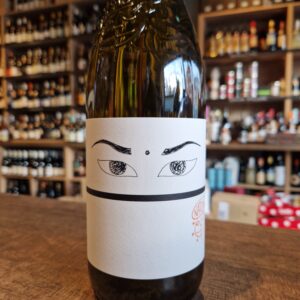 Nat Cool is naturally “cool and funky”. It represents an innovative concept initiated by Niepoort, in which various producers came together to create light, easy-to-drink wines. In the Vinho Verde region, we produced a wine typical of the region – a wine which references the “cloudy” wines of the past which were bottled with some residual sugar and fine lees, and therefore re-fermented in the bottle. Welcome to the Nat Cool world! This white wine was produced using a minimal intervention winemaking approach and is naturally turbid as it fermented in the bottle. It is intentionally not clarified and its aromas are reminiscent of the wines that used to be produced in the Vinho Verde region long ago. This is an intentionally uncomplicated wine: lightly shake the bottle before opening and enjoy with traditional Portuguese snacks!
Nat Cool is naturally “cool and funky”. It represents an innovative concept initiated by Niepoort, in which various producers came together to create light, easy-to-drink wines. In the Vinho Verde region, we produced a wine typical of the region – a wine which references the “cloudy” wines of the past which were bottled with some residual sugar and fine lees, and therefore re-fermented in the bottle. Welcome to the Nat Cool world! This white wine was produced using a minimal intervention winemaking approach and is naturally turbid as it fermented in the bottle. It is intentionally not clarified and its aromas are reminiscent of the wines that used to be produced in the Vinho Verde region long ago. This is an intentionally uncomplicated wine: lightly shake the bottle before opening and enjoy with traditional Portuguese snacks! -
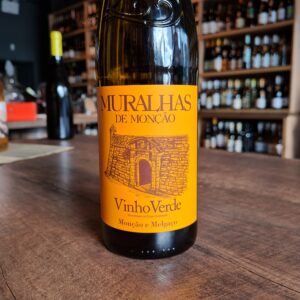 Monção e Melgaço has been producing wines and recognized for it since Roman occupation times, but was with Afonso III, 5th King of Portugal(1210-1279) that signed a ''Foral'' that conceded Monção e Melgaço habitants the owners of the local wine and therefore they produced it with pride as they do today. The wine is made from the Alvarinho (predominant) and Trajadura varieties, indigenous to Portugal and the region, more specifically. The dry Muralhas de Moncao Vinho Verde never seems intrusive, but is soft, elegant and harmonious with no wood whatsoever. The wine goes well not only as an aperitif, but also with salads, seafood, fish dishes and white meat.
Monção e Melgaço has been producing wines and recognized for it since Roman occupation times, but was with Afonso III, 5th King of Portugal(1210-1279) that signed a ''Foral'' that conceded Monção e Melgaço habitants the owners of the local wine and therefore they produced it with pride as they do today. The wine is made from the Alvarinho (predominant) and Trajadura varieties, indigenous to Portugal and the region, more specifically. The dry Muralhas de Moncao Vinho Verde never seems intrusive, but is soft, elegant and harmonious with no wood whatsoever. The wine goes well not only as an aperitif, but also with salads, seafood, fish dishes and white meat. -
Out of stock
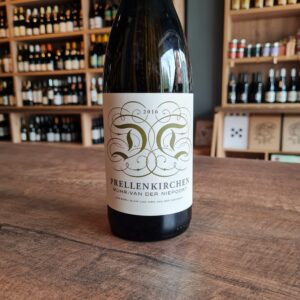 The exciting Muhr-Van der Niepoort project began in 2002 as a collaboration between Austrian PR guru Dorli Muhr and celebrated Portuguese winemaker Dirk Niepoort. Although the name is taken from the village of Prellenkirschen, all of the grapes for the white are sourced from the Spitzerberg, or a continuation of it. A blend of 90% Gruner Veltliner (35 year old vines) and 10% Riesling (planted in 1950), the grapes see some skin contact in the fermentation, imbuing the final wine with tension and extract, a mouth-watering savoury salinity and clearly-delineated spicy flavours of white pepper, fennel and cumin. Deep and a touch wild on the palate but with enormous personality and interest, its deep savoury style will appeal to lovers of edgy yet serious food-friendly whites.
The exciting Muhr-Van der Niepoort project began in 2002 as a collaboration between Austrian PR guru Dorli Muhr and celebrated Portuguese winemaker Dirk Niepoort. Although the name is taken from the village of Prellenkirschen, all of the grapes for the white are sourced from the Spitzerberg, or a continuation of it. A blend of 90% Gruner Veltliner (35 year old vines) and 10% Riesling (planted in 1950), the grapes see some skin contact in the fermentation, imbuing the final wine with tension and extract, a mouth-watering savoury salinity and clearly-delineated spicy flavours of white pepper, fennel and cumin. Deep and a touch wild on the palate but with enormous personality and interest, its deep savoury style will appeal to lovers of edgy yet serious food-friendly whites. -
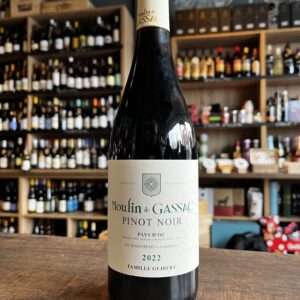 One of the wine films that has had the greatest impact on the industry is undoubtedly Jonathan Nossiter's “Mondovino”. This film was presented at the Cannes Film Festival in 2004, and essentially reflects the conflict between those who understand wine production as a basic artisan work that is completely connected to the land, and those who see it as a corporate business. One of the interviewees featured in the documentary is Aimé Guibert. Creator and champion of the renowned Mas Daumas Gassac, it is thanks to his obsession of giving absolute prominence to the vineyard that he manages to extol the quality of the wines of Languedoc, a region historically known for producing low quality table wines. So when Robert Mondavi, a wine magnate, became interested in this still under used region, Aimé fought with all his might until Mondavi withdrew from his venture. Now, it is his children who continue to protect this legacy with the same passion. A legacy based not so much on the category of the wine as on its quality. Although these wines only carry the vin de pays de l'Oc label, they are considered by great wine specialists to be the “Lafite Rothschilds” of Languedoc-Roussillon.
One of the wine films that has had the greatest impact on the industry is undoubtedly Jonathan Nossiter's “Mondovino”. This film was presented at the Cannes Film Festival in 2004, and essentially reflects the conflict between those who understand wine production as a basic artisan work that is completely connected to the land, and those who see it as a corporate business. One of the interviewees featured in the documentary is Aimé Guibert. Creator and champion of the renowned Mas Daumas Gassac, it is thanks to his obsession of giving absolute prominence to the vineyard that he manages to extol the quality of the wines of Languedoc, a region historically known for producing low quality table wines. So when Robert Mondavi, a wine magnate, became interested in this still under used region, Aimé fought with all his might until Mondavi withdrew from his venture. Now, it is his children who continue to protect this legacy with the same passion. A legacy based not so much on the category of the wine as on its quality. Although these wines only carry the vin de pays de l'Oc label, they are considered by great wine specialists to be the “Lafite Rothschilds” of Languedoc-Roussillon. -
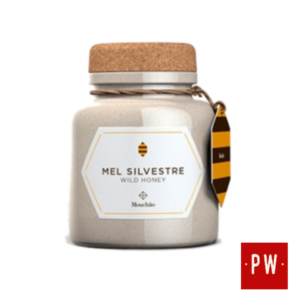 Although beehives have existed in Mouchão for over a century, honey was first commercially sold in 2011. In the expansive and natural surroundings of the estate, bees craft this wild honey with pollen from native shrubs, trees, and wild meadows. Beekeeping intervention is limited almost exclusively to harvesting. The honey, due to its purity, tends to thicken over time and can vary both in consistency and in its darker golden hue. Usually with a thick but smooth texture, it has floral highlights of orange blossom, wild lavender, and jasmine, with undertones of biscuit, butter, and dried fruits. As this is a raw honey, over the months it tends to thicken and can vary both in consistency and in darker golden hues.
Although beehives have existed in Mouchão for over a century, honey was first commercially sold in 2011. In the expansive and natural surroundings of the estate, bees craft this wild honey with pollen from native shrubs, trees, and wild meadows. Beekeeping intervention is limited almost exclusively to harvesting. The honey, due to its purity, tends to thicken over time and can vary both in consistency and in its darker golden hue. Usually with a thick but smooth texture, it has floral highlights of orange blossom, wild lavender, and jasmine, with undertones of biscuit, butter, and dried fruits. As this is a raw honey, over the months it tends to thicken and can vary both in consistency and in darker golden hues. -
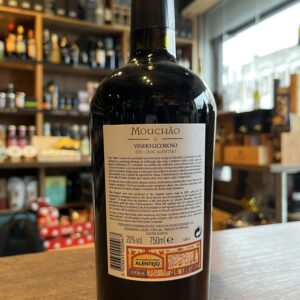
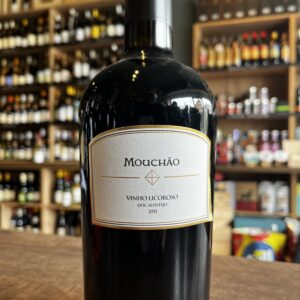 This fortified wine has been produced in Mouchão since the winery was built in 1901. The best grapes from Alicante Bouschet were harvested by hand and trodden by foot in traditional stone presses. The grapes are gently macerated until the fermentation process begins in order to develop a round, subtle and soft mouthfeel. After 120 years, this fortified dessert wine continues to be essential in the homes of Alentejo families at Christmas time. Sold and consumed young, mainly at the beginning of December of the same year of production. Nowadays its popularity is growing outside the festive season and is served in restaurants, very cold after meals. A very traditional and forming part of the tradition of the Northeast Alentejo.
This fortified wine has been produced in Mouchão since the winery was built in 1901. The best grapes from Alicante Bouschet were harvested by hand and trodden by foot in traditional stone presses. The grapes are gently macerated until the fermentation process begins in order to develop a round, subtle and soft mouthfeel. After 120 years, this fortified dessert wine continues to be essential in the homes of Alentejo families at Christmas time. Sold and consumed young, mainly at the beginning of December of the same year of production. Nowadays its popularity is growing outside the festive season and is served in restaurants, very cold after meals. A very traditional and forming part of the tradition of the Northeast Alentejo. -
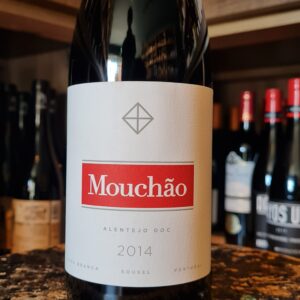 Herdade do Mouchao is a historic winery in Portugal’s Alentejo region that specialises in producing excellent red wines from the local Alicante Bouschet grape. The estate’s roots date back to the 19th century when Thomas Reynolds first moved from Porto to Alentejo to enter the prosperous cork-making industry. Later his grandson, John Reynolds saw an opportunity to start making both wine and corks and purchased the 900 hectare Herdade do Mouchao estate. Vineyards were planted, in 1901 he built a high-ceilinged adobe winery (or “adega”) and a distillery was added to the winery in 1929, where until today Mouchão's pommace brandy is produced. Unfortunately the estate was seized in 1974 by order of the powerful military government ruling the country at the time. The Reynolds were only able to regain the estate in 1985 and today the family works around 38 hectares of vines. Today, the Herdade do Mouchão continues to be run by the descendants of the original family whose cellar and vineyard workers have been with them for generations. The process is, as it always has been, unhurried (There is alway Manana). The grape varieties are local, picked by hand and foot-trodden. In the ever-changing world of winemaking, Herdade do Mouchão, remains a traditional, family-run winery.
Herdade do Mouchao is a historic winery in Portugal’s Alentejo region that specialises in producing excellent red wines from the local Alicante Bouschet grape. The estate’s roots date back to the 19th century when Thomas Reynolds first moved from Porto to Alentejo to enter the prosperous cork-making industry. Later his grandson, John Reynolds saw an opportunity to start making both wine and corks and purchased the 900 hectare Herdade do Mouchao estate. Vineyards were planted, in 1901 he built a high-ceilinged adobe winery (or “adega”) and a distillery was added to the winery in 1929, where until today Mouchão's pommace brandy is produced. Unfortunately the estate was seized in 1974 by order of the powerful military government ruling the country at the time. The Reynolds were only able to regain the estate in 1985 and today the family works around 38 hectares of vines. Today, the Herdade do Mouchão continues to be run by the descendants of the original family whose cellar and vineyard workers have been with them for generations. The process is, as it always has been, unhurried (There is alway Manana). The grape varieties are local, picked by hand and foot-trodden. In the ever-changing world of winemaking, Herdade do Mouchão, remains a traditional, family-run winery. -
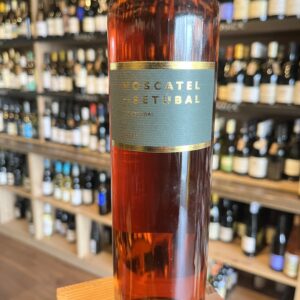
Casa Ermelinda Freitas
The warmth of the Portuguese sun is tempered at Casa Ermelinda thanks to the breezes blowing in from the Atlantic that lies close by. Located at Palmela on the peninsula of Setubal, close to the Sado estuary south of Lisbon, there are currently 440 hectares of many different kinds of vines across the domain, with grapes supplied locally from a further 500ha or so. Head of the company Leonor Freitas has worked tirelessly to make many improvements out in the vineyards and in the winery where modern equipment goes hand in hand with traditional values under the skilled guidance of winemaker Jaime Quendera. Casa Ermelinda Freitas has been run by a long line of dynamic women, celebrating its 100 year anniversary in 2020.
-
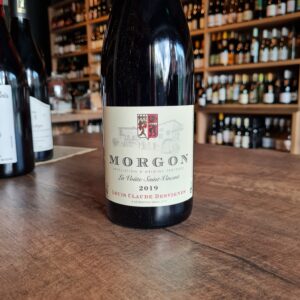 Louis-Claude Desvignes is a family estate that dates back to 1700. The Desvignes range is "La Voûte Saint Vincent", named for the vault or "voûte" of the old family house and for the patron saint of winemakers. It was Louis-Claude who began to turn the estate’s grapes into wine, and now with the reins handed over to his two sons Louis-Benoît and Claude-Emmanuelle Desvignes. It is a blend of certified-organic estate parcels totalling 4.5 hectares in the climat of Douby, which lies in the northeast corner of Morgon along the border of Fleurie. The La Voûte vines average 50 years old and are planted in Douby's typical sandy, decomposed-granite soils. Viticulture and vinification are consistent across all Desvignes wines. In the case of La Voûte, the parcels are all vinified separately.
Louis-Claude Desvignes is a family estate that dates back to 1700. The Desvignes range is "La Voûte Saint Vincent", named for the vault or "voûte" of the old family house and for the patron saint of winemakers. It was Louis-Claude who began to turn the estate’s grapes into wine, and now with the reins handed over to his two sons Louis-Benoît and Claude-Emmanuelle Desvignes. It is a blend of certified-organic estate parcels totalling 4.5 hectares in the climat of Douby, which lies in the northeast corner of Morgon along the border of Fleurie. The La Voûte vines average 50 years old and are planted in Douby's typical sandy, decomposed-granite soils. Viticulture and vinification are consistent across all Desvignes wines. In the case of La Voûte, the parcels are all vinified separately. -
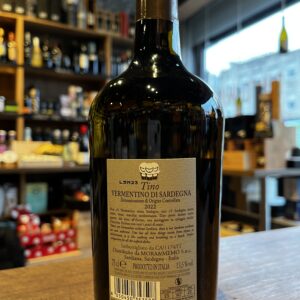
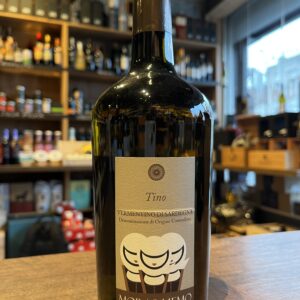 Their Vineyard is located in the south eastern corner of Sardinia in a rolling hill area looking at the sea of the Gulf of Cagliari. Vines with an average age of forty years our vineyards are able to express the best from the terroir of the south Sardinia. A unique terroir with the Sette Fratelli mountains, the tallest ones of the south of the island, just a mile away from the winery, behind them the beatiful beaches overlooking the Thyreenian sea. Pair with seafood in general, fish and delicate meat served with light sauces, soups or pasta.
Their Vineyard is located in the south eastern corner of Sardinia in a rolling hill area looking at the sea of the Gulf of Cagliari. Vines with an average age of forty years our vineyards are able to express the best from the terroir of the south Sardinia. A unique terroir with the Sette Fratelli mountains, the tallest ones of the south of the island, just a mile away from the winery, behind them the beatiful beaches overlooking the Thyreenian sea. Pair with seafood in general, fish and delicate meat served with light sauces, soups or pasta. -
Out of stock
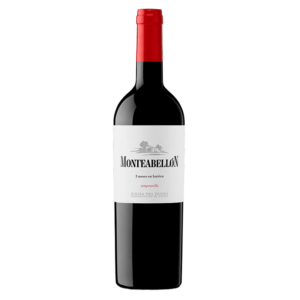 This attractive wine has its origin in the coolest vineyards located near the Douro River. The soil is sandy-loam with a slight gravel content. This gives it a very characteristic freshness that, combined with its aging in the barrel for 5 months (50% French and 50% American), gives rise to a wine with great personality and marked fruity nuances. Intense, bright cherry color. Very intense aroma with marked fruity sensations of blackberry and blueberries perfectly integrated with a quality wood that surrounds everything. Good structure and good fruity expression on the palate, powerful and with ripe tannins. An Oak from Ribera del Duero that you cannot miss.
This attractive wine has its origin in the coolest vineyards located near the Douro River. The soil is sandy-loam with a slight gravel content. This gives it a very characteristic freshness that, combined with its aging in the barrel for 5 months (50% French and 50% American), gives rise to a wine with great personality and marked fruity nuances. Intense, bright cherry color. Very intense aroma with marked fruity sensations of blackberry and blueberries perfectly integrated with a quality wood that surrounds everything. Good structure and good fruity expression on the palate, powerful and with ripe tannins. An Oak from Ribera del Duero that you cannot miss. -
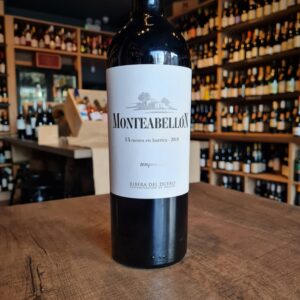 This Monteabellón 14 months is a wine made 100% with Tempranillo grapes from the highest altitude vineyards, located on sandy loam soils with clay and limestone. After a classic vinification, with 25 days of maceration, it is aged for 14 months in barrels of 70% French oak and 30% American . At Bodegas Monteabellón they use the latest oenological techniques to guarantee careful preparation throughout the process, maintaining stable levels of temperature and humidity. Smells of dark, ripe and very rich fruits. Unbelievably full-bodied and the finish is lasting and very long. This 100% Tempranillo is a complex wine that is already very enjoyable to drink, but will continue to develop splendidly over the next few years. Elegant and chocolate all over this wine. A shout to Declan & Mairead as they recommended this lovely addition to Pinto Wines!
This Monteabellón 14 months is a wine made 100% with Tempranillo grapes from the highest altitude vineyards, located on sandy loam soils with clay and limestone. After a classic vinification, with 25 days of maceration, it is aged for 14 months in barrels of 70% French oak and 30% American . At Bodegas Monteabellón they use the latest oenological techniques to guarantee careful preparation throughout the process, maintaining stable levels of temperature and humidity. Smells of dark, ripe and very rich fruits. Unbelievably full-bodied and the finish is lasting and very long. This 100% Tempranillo is a complex wine that is already very enjoyable to drink, but will continue to develop splendidly over the next few years. Elegant and chocolate all over this wine. A shout to Declan & Mairead as they recommended this lovely addition to Pinto Wines! -
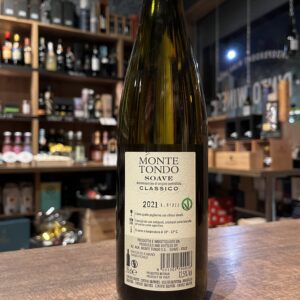
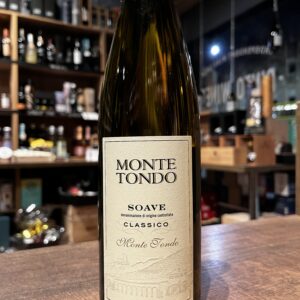
Monte Tondo is a family estate located in the beautiful hillside vineyards of Soave. Here the soils range from volcanic to chalky, which alongside the varying microclimates, gives the wines distinct flavour characteristics and individualistic style.
Alongside his family, winemaker Gino Magnabosco is part of the third generation to run the estate. They believe that hard work, drive, and determination are key to obtaining the best results from their land. Maintaining, nourishing, and cherishing the land of their ancestors is of utmost importance. And although not certified, they farm using organic practices and an environmentally friendly approach to both viticulture and vinification. No chemicals are used in their production and they recycle everything excess coming from the vineyard (stems as fertilizers, skins for grappa, pruned branches for heating and fertilizer).
Small proportions of other varieties are allowed in the production of Soave, but Monte Tondo focus their concentration purely on Garganega. Garganega is a variety so versatile and easily culinary matched but also with the ability to produce complex wines with age-ability.
A very good example of Soave at a very good price. This over-delivers.. Perfect with salads and light fish and shellfish dishes.
-
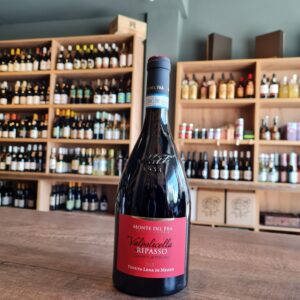 The Monte del Fra Valpolicella Classico appears deep ruby red with ripe red fruit accompanied with spice and earthiness on the nose. The palate displays delicious cherry and plum fruit, locked with sweet liquorice and warm cinnamon, finishing full, with velvety soft tannins and spice. Excellent wine that will get better and better, allow to breathe, even decant and would be best served with roasts, stews, braised meats and strong cheese.
The Monte del Fra Valpolicella Classico appears deep ruby red with ripe red fruit accompanied with spice and earthiness on the nose. The palate displays delicious cherry and plum fruit, locked with sweet liquorice and warm cinnamon, finishing full, with velvety soft tannins and spice. Excellent wine that will get better and better, allow to breathe, even decant and would be best served with roasts, stews, braised meats and strong cheese. -
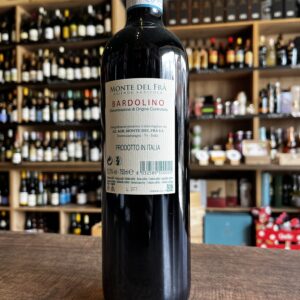
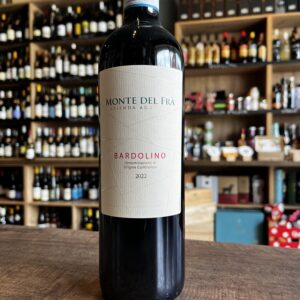 This wine is from the hills that are located in a Guyot at 100/150 meters above sea level, of morainic origin with calcareous, clayey, gravelly, sandy soil.From the municipality of Sommacampagna located southeast of Lake Garda.A well-balanced, fresh and easy-drinking style dry and rounded red wine. Delicately fruity and fragrant, with notes of cherries, strawberries, raspberries and red currants as well as hints of spices. Recommended with light snacks, cold cuts, light meals, tapas, pasta and fish in general (particularly freshwater fish).
This wine is from the hills that are located in a Guyot at 100/150 meters above sea level, of morainic origin with calcareous, clayey, gravelly, sandy soil.From the municipality of Sommacampagna located southeast of Lake Garda.A well-balanced, fresh and easy-drinking style dry and rounded red wine. Delicately fruity and fragrant, with notes of cherries, strawberries, raspberries and red currants as well as hints of spices. Recommended with light snacks, cold cuts, light meals, tapas, pasta and fish in general (particularly freshwater fish). -
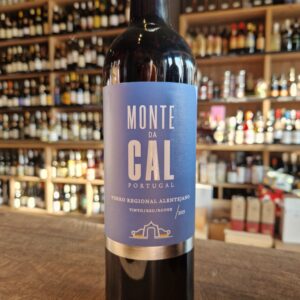 It is in the heart of the genuine Alentejo, with its unique aromas, flavors and textures, nature, silence and immensity, that the 80 hectares of vineyards at Herdade Monte da Cal, located in the municipality of Fronteira, in the parish of São Saturnino, extend over 80 hectares of vineyards. about 40 km from Portalegre. Surrounded by the tranquility of the northern Alentejo plain, it is part of the calm environment of nature characteristic of this part of the country, surrounded by an infinity of vineyards, which we can only see, far away. Here, the red varieties Trincadeira, Syrah, Aragonês, Alicante Bouschet, Alfrocheiro and Touriga Nacional are planted. The architecture and decoration of the estate reflect the Arab influences, so present in the Alentejo culture. The estate’s modern winery is a fundamental pillar to reinforce the visibility of the wines of this house, and a wine tourism project is already planned for this property. Suggested pairing with dishes from the Mediterranean, Chinese, Indian and African cuisine.
It is in the heart of the genuine Alentejo, with its unique aromas, flavors and textures, nature, silence and immensity, that the 80 hectares of vineyards at Herdade Monte da Cal, located in the municipality of Fronteira, in the parish of São Saturnino, extend over 80 hectares of vineyards. about 40 km from Portalegre. Surrounded by the tranquility of the northern Alentejo plain, it is part of the calm environment of nature characteristic of this part of the country, surrounded by an infinity of vineyards, which we can only see, far away. Here, the red varieties Trincadeira, Syrah, Aragonês, Alicante Bouschet, Alfrocheiro and Touriga Nacional are planted. The architecture and decoration of the estate reflect the Arab influences, so present in the Alentejo culture. The estate’s modern winery is a fundamental pillar to reinforce the visibility of the wines of this house, and a wine tourism project is already planned for this property. Suggested pairing with dishes from the Mediterranean, Chinese, Indian and African cuisine. -
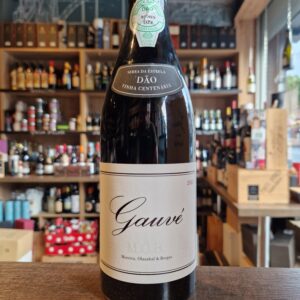 This project was born from the will of three winemakers, Jorge Moreira, Francisco Olazabal and Jorge Serôdio Borges, to make a wine together. The chosen region was the Dão, a region for which there is a common admiration that was born in the tasting of older wines, from the 60s and 70s that surprise for their elegance and freshness. The identity and complexity of these wines is indeed remarkable and serves as an inspiration for MOB wines.
This project was born from the will of three winemakers, Jorge Moreira, Francisco Olazabal and Jorge Serôdio Borges, to make a wine together. The chosen region was the Dão, a region for which there is a common admiration that was born in the tasting of older wines, from the 60s and 70s that surprise for their elegance and freshness. The identity and complexity of these wines is indeed remarkable and serves as an inspiration for MOB wines.


